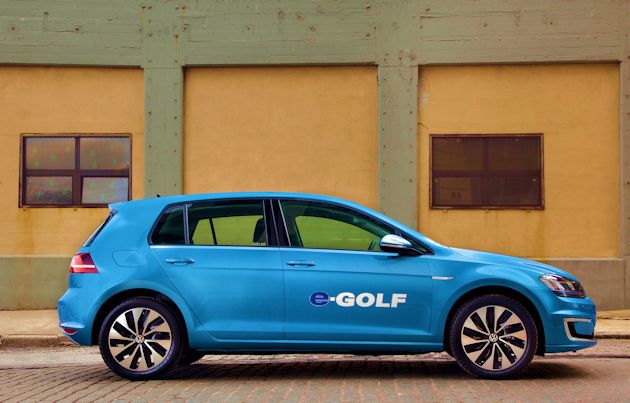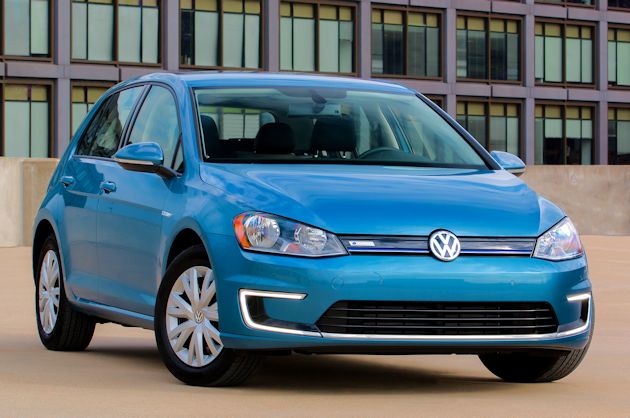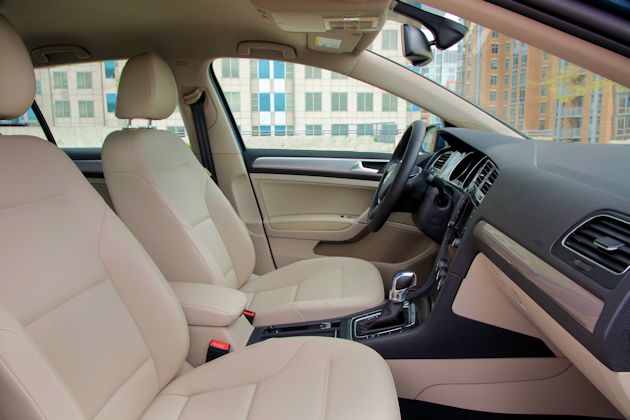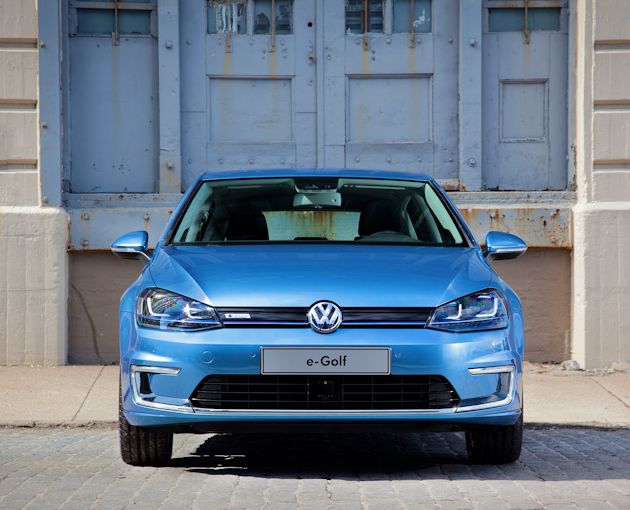Barbara & Bill Schaffer
After a week driving the 2015 Volkswagen e-Golf for our normal running around and shopping, we concluded it could be a perfect second car for our lifestyle.
For the other car we?d need something like one of the Volkswagen TDIs (diesels), because we take several longer road trips each year to neighboring states and frequent shorter trips to the coast, Central Oregon and Seattle from our home near Portland, Ore.
 Starting out with a range of from 74 to 83 miles listed on the e-Golf?s range gauge we went shopping, to the doctor?s office, library, etc. Every trip we returned home with at least 40 miles range remaining.
Starting out with a range of from 74 to 83 miles listed on the e-Golf?s range gauge we went shopping, to the doctor?s office, library, etc. Every trip we returned home with at least 40 miles range remaining.
In our case, we always got a starting bonus of five to eight miles range thanks to the steep mile-long hill we live on. The regenerative braking system feeds back energy into the batteries during braking or coasting as we drove down hill to the main highway. Of course, at the end of the trip we lost nearly as much range going back up the hill.
 Battery-powered vehicles are especially popular in the areas like Portland, because there is a big push to be ?green? and to drive low or zero emissions vehicles. To keep them charged, plans call for more than 1,000 public charging stations (plus an additional 1,000 corporate stations) in the Willamette Valley which runs from Portland south for about 150 miles.
Battery-powered vehicles are especially popular in the areas like Portland, because there is a big push to be ?green? and to drive low or zero emissions vehicles. To keep them charged, plans call for more than 1,000 public charging stations (plus an additional 1,000 corporate stations) in the Willamette Valley which runs from Portland south for about 150 miles.
We pushed our limit on one outing but stopped to shop Kohl?s. The store has three Level 2 (240-volt) chargers, and we are familiar with how it worked from a previous charging experience. After shopping about a half hour, our range was back up to nearly 70 miles.
 The e-Golf has a standard 7.2 kW onboard charger which enables e-Golf?s battery to be recharged in any of three ways. The standard charging cable can plug into any 110/120-volt electrical socket and fully charge the battery in roughly 20 hours. Using a 240-volt plug-in, it gets the full 7.2 kW to charge a battery in less than four hours. The e-Golf is also equipped with a standard Combined Charging System (CCS) which allows the car to use the SAE standard DC fast charging infrastructure, which is available at some charge stations. It delivers direct power at up to 50 kW, charging the battery to about 80 percent capacity in about 30 minutes.
The e-Golf has a standard 7.2 kW onboard charger which enables e-Golf?s battery to be recharged in any of three ways. The standard charging cable can plug into any 110/120-volt electrical socket and fully charge the battery in roughly 20 hours. Using a 240-volt plug-in, it gets the full 7.2 kW to charge a battery in less than four hours. The e-Golf is also equipped with a standard Combined Charging System (CCS) which allows the car to use the SAE standard DC fast charging infrastructure, which is available at some charge stations. It delivers direct power at up to 50 kW, charging the battery to about 80 percent capacity in about 30 minutes.
The 2015 Volkswagen e-Golf is powered by a lithium-ion battery, which is mounted in the car?s center tunnel just ahead of the rear axle and below the rear seats. The battery is composed of 264 individual prismatic cells, which are efficient enough that the battery doesn?t require any active cooling systems. Co-developed with Panasonic, the cells are integrated in 27 modules of either six or twelve cells each, which collectively produce a nominal rating of 323 volts and an overall capacity of 24.2 kWh. The battery has a limited warranty that covers eight years or 100,000 miles against 70 percent capacity.
 The motor is a synchronous permanent-magnet alternating current (AC) motor, which operates at 12,000 rpm. The compact electric motor sends its power to the front wheels through a single-speed transmission; both the motor and transmission are designed and built by Volkswagen. In the standard drive mode, it?s capable of delivering 199 lb.ft. of torque and 115 horsepower.
The motor is a synchronous permanent-magnet alternating current (AC) motor, which operates at 12,000 rpm. The compact electric motor sends its power to the front wheels through a single-speed transmission; both the motor and transmission are designed and built by Volkswagen. In the standard drive mode, it?s capable of delivering 199 lb.ft. of torque and 115 horsepower.
To save power during cold weather, the e-Golf has a new heat pump system which uses both ambient air and heat from the drive system components to warm the cabin rather than relying solely on the high-voltage heater.
 The driver can select from three drive profiles — ?Normal?, ?Eco?, and ?Eco+?. In the ?Normal? mode the e-Golf accelerates to 60 mph from rest in just over 10 seconds and has a top speed limited to 87 mph. With the instant torque from the electric motor, the performance feels faster than the numbers indicate. The ?Eco? modes cut the power, acceleration and top speed, but extends the range. Regardless of the drive mode selected, full accelerator pedal ?kick-down? will result in the maximum power and performance of the ?Normal? mode.
The driver can select from three drive profiles — ?Normal?, ?Eco?, and ?Eco+?. In the ?Normal? mode the e-Golf accelerates to 60 mph from rest in just over 10 seconds and has a top speed limited to 87 mph. With the instant torque from the electric motor, the performance feels faster than the numbers indicate. The ?Eco? modes cut the power, acceleration and top speed, but extends the range. Regardless of the drive mode selected, full accelerator pedal ?kick-down? will result in the maximum power and performance of the ?Normal? mode.
The driver can also select from three levels of regenerative braking control the amount of energy that can be recuperated from braking or coasting. If the battery is fully charged and the vehicle is in standard ?D? mode, no regenerative braking will occur. If you lift off the accelerator pedal or tap the shift lever to the left, the first level of regenerative braking, ?D1,? is activated, supplying a small amount of recuperated energy (and the car is slowed slightly). Levels ?D2? and the maximum ?D3?/?B? increase the levels of energy regeneration even more.
 The EPA lists fuel economy as the equivalent of 126 mpg city, 105 mpg highway and 116 mpg combined. In electronic terms it uses 29 kW-hours per 100 miles. Transferred into dollars and cents, the e-Golf Monroney lists annual fuel cost of $550, saving $8,250 in fuel over a five year period as compared to the average new vehicle.
The EPA lists fuel economy as the equivalent of 126 mpg city, 105 mpg highway and 116 mpg combined. In electronic terms it uses 29 kW-hours per 100 miles. Transferred into dollars and cents, the e-Golf Monroney lists annual fuel cost of $550, saving $8,250 in fuel over a five year period as compared to the average new vehicle.
 Because the 2015 Volkswagen e-Golf shares its design and most components with the other four-door Golf models, it?s difficult to distinguish it from the other models. It is the only Volkswagen, however, to use energy efficient LED headlights. It also uses C-shaped LED daytime running light strips in the bumper below. Other clues that this is an all-electric VW are the unique badges and blue accents, as well as the obvious lack of any tailpipes at the rear.
Because the 2015 Volkswagen e-Golf shares its design and most components with the other four-door Golf models, it?s difficult to distinguish it from the other models. It is the only Volkswagen, however, to use energy efficient LED headlights. It also uses C-shaped LED daytime running light strips in the bumper below. Other clues that this is an all-electric VW are the unique badges and blue accents, as well as the obvious lack of any tailpipes at the rear.
To maximize its aerodynamic efficiency, the e-Golf uses special aerodynamic 16-inch wheels which fit tightly with the wheel arches to improve airflow. Other aerodynamic improvements include low rolling resistance tires, a radiator shutter and grille, underbody paneling, rear spoiler and C-pillar air vanes. The net result is an excellent 0.27 coefficient of drag.
 Inside, the e-Golf looks much like the other Golf models and the interior space with no space taken up by the battery. Cargo space is 22.8 cubic feet with the rear seatbacks up and 52.7 cubic feet when the seats are folded. The instrument cluster has been redesigned for the electric vehicle?s informational needs.
Inside, the e-Golf looks much like the other Golf models and the interior space with no space taken up by the battery. Cargo space is 22.8 cubic feet with the rear seatbacks up and 52.7 cubic feet when the seats are folded. The instrument cluster has been redesigned for the electric vehicle?s informational needs.
 As with the other Golf models, the interior materials are high quality and it appears to be well-built. Because the engine sounds are eliminated, noise from the tires and wind in electric vehicles can be more noticeable so engineers fitted the interior with highly sound absorbent materials, to create a cabin space quieter than many luxury vehicles. Because there?s no engine noise they also installed a low-speed sound system to help alert pedestrians to the vehicle.
As with the other Golf models, the interior materials are high quality and it appears to be well-built. Because the engine sounds are eliminated, noise from the tires and wind in electric vehicles can be more noticeable so engineers fitted the interior with highly sound absorbent materials, to create a cabin space quieter than many luxury vehicles. Because there?s no engine noise they also installed a low-speed sound system to help alert pedestrians to the vehicle.
Because the e-Golf is a premium model, planners also added a high level of standard and available equipment including: a touchscreen navigation system, VW CarNet? connected services; KESSY? Keyless access with push-button start; heatable front seats; Bluetooth? technology; SiriusXM? Satellite Radio; a rearview camera; and front and rear Park Distance Control.
One of the most significant advances in the new Golf comes in the form of its new touchscreen infotainment center, standard on all models. At 5.8-inches in size, the display utilizes a capacitive touch sensor (as in smartphone and tablet technology) rather than the more common resistive touchscreens that require pressure, enabling gesture controls like swiping and even pinch-zooming.
 A new Limited Edition Volkswagen e-Golf was added to the lineup in March with a starting price of $34,270, including the destination charge. It joins the e-Golf SEL Premium model we tested, which is priced at $36,265. When you take off the $7,500 Federal tax credit, any local incentives, fuel savings and the limited service required, it becomes a very good value.
A new Limited Edition Volkswagen e-Golf was added to the lineup in March with a starting price of $34,270, including the destination charge. It joins the e-Golf SEL Premium model we tested, which is priced at $36,265. When you take off the $7,500 Federal tax credit, any local incentives, fuel savings and the limited service required, it becomes a very good value.
Of all the competitive electric vehicles the 2015 Volkswagen e-Golf is one of our favorites because it is so simple and versatile. We liked that we?d go out, run our errands and come home, pop-open the charger port, which replaces the fuel filler, and plug it in. The next morning the car was fully charged and ready to go. It works great when used in our Metro area, but we?d still need a second car for those road trips we love.









